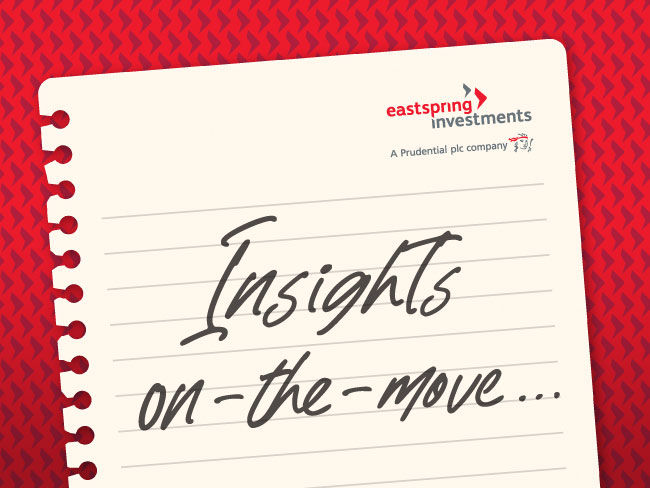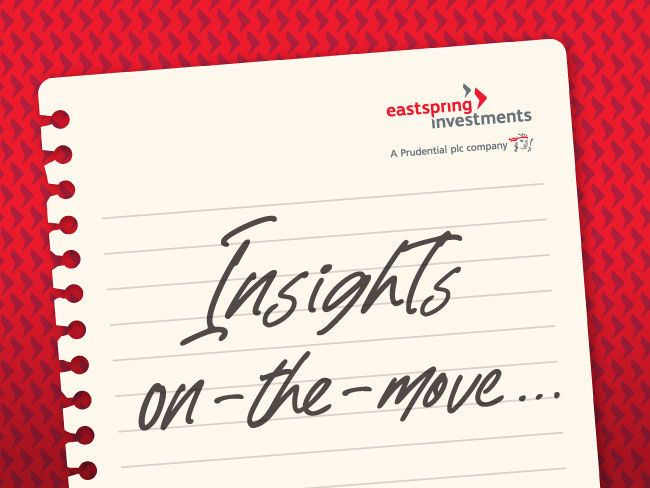Executive Summary
My trip to China had two goals: one to get a pulse-check on the Chinese economy — especially timely after Trump’s “Liberation Day” tariffs—and to identify new investment trends. My key observations:
- Investor sentiment has improved, and China has shed its “un-investable market” label from the zero-COVID era. This renewed interest was evident at the conference I attended, which recorded multi-year high attendance. I met some global fund managers that were looking at China for the first time.
- Rather than second-guessing trade talks, investors are assessing tariff resilience. Meanwhile China’s strength in advanced manufacturing—marked by rapid R&D and cost efficiency—positions its firms, especially component suppliers, to aggressively pursue market share.
- Chinese equities offer more than just growth—they are becoming a strong source of yield in Asia Pacific. Many Chinese firms now offer both growth and steady dividends, especially in key sectors like consumer and industrials.
Shanghai remains vibrant as ever. Since my last visit in 2018, the notable changes are:
- the intensification of organised retail (with the influx of international retail brands),
- the rise of domestic retail champions (e.g., luxury gold, electric vehicles, blind box toys), and
- the rise of domestic tourism; the strength of domestic tourism was clearly evident on May 20th - an informal Valentine’s Day in China — as the Bund was packed with local tourists
These observations reflect the diversity of growth within China, beyond the headline sub-5% GDP growth figure.
Value-creating traits
During my trip, I met with a diverse range of corporates—from banks and consumer firms to logistics providers and industrial manufacturers. Growth has been uneven in recent years, more so amid the trade war, but those showing resilience shared a common ability to create and capture value through four distinct traits:
1. Deep consumer understanding
Companies that know what customers want (before they do), stay ahead. The resurgence of “new consumption” stocks (i.e., blind box toys, pet food, luxury gold jewellery, cosmetics) are such examples. These companies have not created revolutionary products but have been successful because of their ability to create inherent value. This value, perceived or otherwise, provides pricing power and defies broader consumption downtrends.
2. New product use cases
Companies that continuously redefine the use cases of their products are unlocking new growth. China’s industrial sector is a prime example, having transitioned from low-end manufacturing to electric vehicles (EVs), and now industrial automation. I met a company that started off making elevator drive units, pivoted into manufacturing industrial automation equipment, and is now developing components for humanoid robots. Each pivot expands their addressable market and enhances value creation.
3. Emerging trend beneficiaries
Artificial Intelligence (AI) is a recent example of emerging trends. China’s AI innovations emerged as a response to the need to do more with less, due to limited access to advanced computing chips. This has resulted in a surge of growth across China’s domestic AI ecosystem, independent of global developments. Domestic champions are emerging from semiconductor foundries to datacentre operators.
4. Market competition survivors
Companies that survive intensive competitive wars are likely to dominate the market. For example, a ride-hailing firm I met now commands a dominant 70% market share after years of rivalry. It is now shifting focus to profitability by reducing user subsidies. Meanwhile, the food delivery space is entering a new phase of competition, with players adopting a “winner-takes-all” mindset.
Varied tariff impacts
In general, investors I met at the conference were less concerned with trade negotiation outcomes and focused on two key issues: the impact of tariffs on demand and profitability, and how companies mitigate these impacts—either by passing through costs or production relocation.
Companies with a manufacturing edge and whose products form a small portion of their customers’ bill-of-materials cost were better able to pass on tariff costs. There are also firms that have opted not to relocate, citing labour constraints and poor returns.
One industrial parts manufacturer said that their US customer was willing to absorb 70% of tariff costs, even when tariffs were set at 145%. As the manufacturer is a strategic Tier 1 parts supplier, finding alternative suppliers or relocating production facilities would have been much more costly for the US customer.
Humanoid field trip insights
Apart from meetings, I also joined a field trip to understand China’s advancements in humanoids and industrial automation. The concept of industrial automation (which humanoid robots are a part of) is not new, and industrial robots are widely in use. This trip served as a reminder of China’s advanced manufacturing capabilities—it is hard to find a supply chain that can achieve both rapid prototyping/R&D and aggressive cost downs.
Humanoids present a stronger use-case for all-purpose applications that require replication of physical human capabilities. Humanoid robots offer versatility, but lower task efficiency compared to other variants. Humanoid developments are work-in-progress, and no single player has perfected the product.
Replicating human capabilities is complicated and requires a combination of hardware (actuators, sensors etc.) and software (motion/gait stability, real world spatial awareness). There are gaps in both aspects, particularly in fine motor skills and spatial awareness. Nonetheless Chinese players benefit from a cost advantage, with volume production playing a key role in driving down prices.
With most humanoid robot manufacturers unlisted, component suppliers offer a practical way to invest in the theme. Successful suppliers are those that can produce high-quality components at low cost, while adding value through R&D—particularly in miniaturisation, reliability and improving mean time between failure. I met a small parts supplier with the ability to spec out over three hundred component blueprints for potential customers, requiring production lead time as little as three to six months. Another supplier is using innovative materials to enhance product durability, reflecting the sector’s innovation capabilities.
From growth to yield
As style-agnostic investors, we seek opportunities across the value-growth spectrum, with a forward-looking view on income. Today’s growth companies can evolve into tomorrow’s stable cashflow generators.
While growth remains a compelling narrative, Chinese equities offer more than just capital appreciation—they are increasingly a rich source of yield within Asia Pacific. In fact, many Chinese companies now combine growth potential with consistent dividend payouts, particularly in sectors like communication services, consumer, industrials, and utilities.
Yield investing has been a key theme for Chinese equities in the past 12 months, especially since domestic interest rates remain low. Corporates are placing greater emphasis on shareholder returns, initiating dividend and buyback policies, even if modestly.
As this trend is gaining momentum, it makes sense to start investing in today’s growth companies with the potential to become tomorrow’s high dividend yielders.
Singapore by Eastspring Investments (Singapore) Limited (UEN: 199407631H)
Australia (for wholesale clients only) by Eastspring Investments (Singapore) Limited (UEN: 199407631H), which is incorporated in Singapore, is exempt from the requirement to hold an Australian financial services licence and is licensed and regulated by the Monetary Authority of Singapore under Singapore laws which differ from Australian laws
Hong Kong by Eastspring Investments (Hong Kong) Limited and has not been reviewed by the Securities and Futures Commission of Hong Kong.
Indonesia by PT Eastspring Investments Indonesia, an investment manager that is licensed, registered and supervised by the Indonesia Financial Services Authority (OJK).
Malaysia by Eastspring Investments Berhad (200001028634/ 531241-U) and Eastspring Al-Wara’ Investments Berhad (200901017585 / 860682-K).
Thailand by Eastspring Asset Management (Thailand) Co., Ltd.
United States of America (for institutional clients only) by Eastspring Investments (Singapore) Limited (UEN: 199407631H), which is incorporated in Singapore and is registered with the U.S Securities and Exchange Commission as a registered investment adviser.
European Economic Area (for professional clients only) and Switzerland (for qualified investors only) by Eastspring Investments (Luxembourg) S.A., 26, Boulevard Royal, 2449 Luxembourg, Grand-Duchy of Luxembourg, registered with the Registre de Commerce et des Sociétés (Luxembourg), Register No B 173737.
Chile (for institutional clients only) by Eastspring Investments (Singapore) Limited (UEN: 199407631H), which is incorporated in Singapore and is licensed and regulated by the Monetary Authority of Singapore under Singapore laws which differ from Chilean laws.
The afore-mentioned entities are hereinafter collectively referred to as Eastspring Investments.
The views and opinions contained herein are those of the author, and may not necessarily represent views expressed or reflected in other Eastspring Investments’ communications. This document is solely for information purposes and does not have any regard to the specific investment objective, financial situation and/or particular needs of any specific persons who may receive this document. This document is not intended as an offer, a solicitation of offer or a recommendation, to deal in shares of securities or any financial instruments. It may not be published, circulated, reproduced or distributed without the prior written consent of Eastspring Investments. Reliance upon information in this document is at the sole discretion of the reader. Please carefully study the related information and/or consult your own professional adviser before investing.
Investment involves risks. Past performance of and the predictions, projections, or forecasts on the economy, securities markets or the economic trends of the markets are not necessarily indicative of the future or likely performance of Eastspring Investments or any of the funds managed by Eastspring Investments.
Information herein is believed to be reliable at time of publication. Data from third party sources may have been used in the preparation of this material and Eastspring Investments has not independently verified, validated or audited such data. Where lawfully permitted, Eastspring Investments does not warrant its completeness or accuracy and is not responsible for error of facts or opinion nor shall be liable for damages arising out of any person’s reliance upon this information. Any opinion or estimate contained in this document may subject to change without notice.
Eastspring Investments companies (excluding joint venture companies) are ultimately wholly owned/indirect subsidiaries of Prudential plc of the United Kingdom. Eastspring Investments companies (including joint venture companies) and Prudential plc are not affiliated in any manner with Prudential Financial, Inc., a company whose principal place of business is in the United States of America or with the Prudential Assurance Company Limited, a subsidiary of M&G plc (a company incorporated in the United Kingdom).














